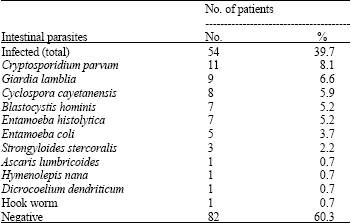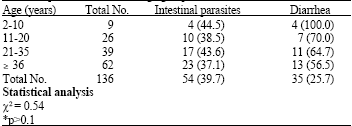Research Article
Intestinal Parasites Infection among Immunocompromised Patients in Riyadh, Saudi Arabia
Department of Biology, Science College, Princess Nora Bint Abdul Rahman University, P.O. Box 25701, Riyadh 11476, Saudi Arabia
Infections caused by intestinal parasites are widespread (Savioli et al., 1992). Current assessments suggest that at least 25% of the world’s population is chronically infected by enteric parasites (World Health Organization, 1987). These infections would be expected to be appreciably higher in developing countries due to higher prevalence of infections in the general population. However, Intestinal opportunistic parasitic infections in Human Immunodeficiency Virus (HIV)-infected subjects present commonly as diarrhea (Mohandas et al., 2002). Although, HIV infection is not highly prevalent in the Middle East (Grant and Decock, 1998), it is a rapidly spreading infection in this region (World Health Organization, 2003). Globally it was estimated that 42 million people were HIV-infected with the majority of patients (29.4 million) from Africa (UNAIDS/WHO, 2002). Since, the first described cases of acquired immunodeficiency syndrome (AIDS), a high prevalence of gastrointestinal infections has been reported in such patients, in the form of diarrhea associated with parasitosis. Thus infections in the gastrointestinal tract play a fundamental role in the morbidity and mortality of AIDS patients. The incidence of these infections was 50% in the developed countries, whereas it reaches up to 95% in developing countries, such as Hiati and some African countries (Smith et al., 1988; Quinn, 1996). Many factors including poverty and malnutrition could promote the spread of infections in the region. Attempts to improve the underlying conditions may revert the situation. Studies investigated the existence of interaction between HIV and parasitic infections in co-infected individuals. Parasitic infections particularly helminthes cause chronic immune activation (Grossman et al., 2002; Borkow and Bentwich, 2004). Though proving evidences are insufficient, such immune modulation was shown to increase host susceptibility, thereby, promoting HIV infection and disease progression (Shapira-Nahor et al., 1998; Kalinkovich et al., 2001; Secor et al., 2003).
The purpose of this study was to evaluate the prevalence of common intestinal parasites among HIV-infected patients in Riyadh city, Saudi Arabia.
Fecal samples were collected from 136 immunocompromised patients (52 females and 84 males),aged 2 to 69 years. These samples were collected from King Khalid University Hospital and Riyadh Armed Forces Hospital in Riyadh city, Saudi Arabia during the period from June 2004 to May 2005.
A single fecal sample was collected from each patient. Samples were collected in sterile plastic containers and transported to the laboratory.
Specimens were fixed with 10% formalin for 30 min (2-3 g fecal-1) and then concentrated by a formalin-ether sedimentation technique. Samples were examined as wet saline mounts and in iodine preparation for detection of protozoan oocysts, cysts, helminthic eggs and larvae (Chessbrough, 1998). Permanent stained smears were performed for intestinal coccidian parasites by the modified Ziehl-Neelsen technique according to Garcia et al. (1983) and modified trichrome stain according to Ryan et al. (1993).
Chi-Square test was used to compare the difference in the prevalence of intestinal parasites presenting with diarrhea and the age and sex of the patients, the differences were considered significant if P was less than 0.05 (Greenwood and Nikulin, 1996).
Detection of intestinal parasites in the fecal samples collected from immunocompromised patients is shown in Table 1 and association between the presence of parasites with diarrhea are shown in Table 2 while the prevalence of intestinal parasites among immunocompromised patients of different age groups is shown in Table 3. Table 4 showed prevalence of intestinal parasites among males and females immunocompromised patients. Out of the 136 immunocompromised patients examined, 54 were positive for intestinal parasitic infections, giving an overall prevalence of diarrhea in 35 of the sufferers (39.7%) (Cimerman et al., 1999; Kumar et al., 2002; Mohandas et al., 2002; Zali et al., 2004; Tadesse and Kassu, 2005; Wiwanitkit, 2006; Kurniawan et al., 2009; Saksirisampant et al., 2009). Single species parasitic infections were detected in 28.6% patients, while multiple parasites were found in 11.1% of infected patients (Tadesse and Kassu, 2005; Assefa et al., 2009; Kurniawan et al., 2009).
More specifically the following parasites were detected Cryptosporidium parvum, Giardia lamblia, Cyclospora cayetanensis, Blastocystis hominis, Entamoeba histolytica, Entamoeba coli, Strongyloides stercoralis, Ascaris lumbricoides, Hymenolepis nana, Dicrocoelium dendriticum and Hook worm. C. parvum was the most common parasite detected (from 8.1% of infected patients).
| Table 1: | Detection of intestinal parasites infections among immunocompromised patients |
 | |
| N = 136 | |
| Table 2: | Association between the presence of intestinal parasites with diarrhea in immunocompromised patients |
 | |
| *Statistically significant association. Values in brackets indicate percentage | |
| Table 3: | Detection of intestinal parasites among immunocompromised patients of different age groups |
 | |
| *p>0.1 no significant difference between age groups. Values in brackets indicate percentage | |
This rate of prevalence in immunocompromised patients is close to that previously reported in Northern India as it had been detected in 10.8% of infected patients (Mohandas et al., 2002), in Bogota, Colombia (10.4%) (Florez et al., 2003), it is higher than that noticed in Jakarta, Indonesia (4.9%) (Kurniawan et al., 2009), but significantly lower than what had been reported earlier in Saudi Arabia (69.7%) by Sanad and Al-Malki (2007).
| Table 4: | Detection of intestinal parasites among immunocompromised patients among males and females |
 | |
| *p>0.1 no significant difference between males and females. Values in brackets indicate percentage | |
Also, lower to what had been reported from North West Ethiopia (29, 20.1%) and Bamako, Mali (20%) (Tadesse and Kassu, 2005; Assefa et al., 2009; Konate et al., 2005). Giardia lamblia was the second most common parasite detected (in 6.6% patients) and this rate is close to that found in patients in Northern India (8.3% affected) (Mohandas et al., 2002), Iran (7.3% sufferers) (Zali et al., 2004), higher than that previously reported in Jakarta, Indonesia (1.9% infected) (Kurniawan et al., 2009) and significantly lower than that rate of infection of patients reported previously in Western Nepal (67.7%) (Mukhopadhyay et al., 2007), Brazil (16%) (Cimerman et al., 1999) and Ethiopia (11.2%) (Assefa et al., 2009). C. cayetanensis was the third most common parasite detected (5.9%), this rate is higher than that previously reported in Chennai, India (1.69%) (Kumar et al., 2002), Northern India (3.3%) (Mohandas et al., 2002) and Jakarta, Indonesia (4.5%) (Kurniawan et al., 2009). In most of patients there was a significant association between infections with C. parvum, G. lamblia and C. cayetanensis and the incidence of diarrhea (Table 2) which is similar to what had been recorded earlier by Zali et al. (2004), furthermore the relationship between C. parvum infection and its association with diarrhea as an important pathogen was well documented by Kumar et al. (2002) and Moghaddam (2007). Detection rate of B. hominis was close to detection rate of C. cayetanensis (5.2%) and both are close to that previously reported in Iran (4.4%) (Zali et al., 2004), India (3.3%) (Mohandas et al., 2002) higher than that previously reported in Brazil (0.5%) (Cimerman et al., 1999) and very lower than that previously reported in Bogota, Colombia (59.1%) (Florez et al., 2003) and Jakarta, Indonesia (72.4%) (Kurniawan et al., 2009). Detection of E. histolytica recorded the same rate (5.2%) and it was higher than that previously reported in Northern India (1.7%) (Mohandas et al., 2002). However, relatively lower than that previously reported in Western Nepal (27.7%) (Mukhopadhyay et al., 2007), Bogota, Colombia (25.2%) (Florez et al., 2003) and Ethiopia (24.8%) (Assefa et al.,2009). E. coli recorded a rate of 3.7% which is close to that recorded in Iran (3.9%) (Zali et al., 2004). However the current rate was higher than that previously reported in Northern India (0.8%) (Mohandas et al., 2002) and Ethiopia (1.9%) (Assefa et al., 2009), but it was lower than that in Brazil (13%) (Cimerman et al., 1999). S. stercoralis recorded a rate 2.2% higher than that previously recorded in Iran (0.9%) (Zali et al., 2004) and lower than that previously reported in Ethiopia (12.6%) (Assefa et al., 2009) and North-West Ethiopia (17%) (Tadesse and Kassu, 2005). Other parasites were detected in this study (A. lumbricoides, H. nana, D. dendriticum and Hook worm) were found in 0.7% immunocompromised patients without diarrhea this result was consistent with what has been recorded by Zail et al. (2004) for H. nana (0.9%), D. dendriticum (0.4%), Mohandas et al. (2002) for Hook worm (0.8%), while A. lumbricoides previously recorded in Brazil (2.5%) and Ethiopia (12.2%) (Cimerman et al., 1999; Assefa et al., 2009).
The infection rates in different age group ranged from less than 37.1% in adults ≥ 36 years of age to more than 44.5% in 2-10 year old children. In other age groups, the infection rates were comparable. However, no significant differences were observed between different age groups. This prevalence rate is lower than that reported three years ago in immunocompromised patients in Riyadh (Sanad and Al-Malki, 2007).
The age distribution of intestinal parasites among immunocompromised patients in the present study suggests that the infection tends to be more common in 2-10 year old children (44.5%) (Simpore et al., 2009). However, no significant differences were observed between different age groups.
As shown in Table 4, the detection of intestinal parasites among female and male immunocompromised patients were 38.8 and 39.3%, respectively, indicating that both genders are equally susceptible to infection. This agrees with the findings of Zali et al. (2004).
The observation of the consistency of fecal of immunocompromised patients could help in the presumptive diagnosis of opportunistic protozoan infections and allow parasitological investigation to be targeted at the cases most likely to be found positive. The high risk group of HIV patient to gastrointestinal parasites infection are the children between 2-10 years old and this particular group must receive special attention when they attend the clinic and must be tested for parasites products and treated accordingly.
The present study highlights the importance of testing for intestinal parasites in immunocompromised patients and emphasizes the necessity awareness among clinicians regarding the occurrence of these parasites in this population and health education of the population for food hygiene. The frequency and the danger of those opportunistic infections require their efficient diagnosis and appropriate management.